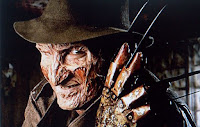Hello, kiddies! Thanks for tuning in to my latest blog post-mortem!! Hehehehehheheeeee!!
Pop culture again. Ahhh, those were the days…
So, last year at this time I talked about a couple of the subgenres horror can be broken down into. It’s important to know which group your tale of terror sits best with so you know how to approach the different elements and the way they mesh together. Knowing this also helps to sell it and promote it.
By the same token, when you sit down to write something “scary,” it can help to know just what you’re hoping to accomplish.  People get their heads cut off in the Saw movies, in Attack of the Clones, in The Man in the Iron Mask, and in A Mighty Heart, but these decapitations are all received in very different ways because of how their particular stories are being told. In the same way, Freddy Kruger has been a slasher, a monster, and a plain old villain, even though the character has barely changed at all. How, exactly, do you intend to scare your readers with this moment as opposed to that one? Or are they supposed to evoke the same kind of fear?
People get their heads cut off in the Saw movies, in Attack of the Clones, in The Man in the Iron Mask, and in A Mighty Heart, but these decapitations are all received in very different ways because of how their particular stories are being told. In the same way, Freddy Kruger has been a slasher, a monster, and a plain old villain, even though the character has barely changed at all. How, exactly, do you intend to scare your readers with this moment as opposed to that one? Or are they supposed to evoke the same kind of fear?
You can nitpick back and forth, but I think fear, as a sensation, generally breaks down into three basic categories. There’s a couple different names people use for them, but for our purposes today, let’s call them the shocker, the gross out, and dread. These three form the food pyramid of fear, if you will, which means using and combining them in the right ways can make a variety of tasty seasonal treats.
…starting to sound like a cooking blog…
Anyway…
The Shocker– This is when something unexpected happens and makes the audience jump. It’s the fear of what’s happening right at this moment. If you’ve ever watched someone read and seen their eyes bug, they probably just hit a shocker. Ever been in a theater when most everyone screams? Same thing. When someone walks around the camp cabin and Jason buries his machete in their skull, that’ll make you jump even watching a movie where you know people are going to get machetes in the skull. When Michael suddenly shoots Ana Lusia on LOST, that’s a shocker, too. Individual shocks can be stretched out a bit–especially on film– with lots of shouting and chaos and a few smaller shocks to keep it going, but really a shock is a short-lived thing.
The shocker is powerful, but it’s important for writers to remember it can’t stand on its own for long. As I’ve mentioned before, a good way to think of shocks is like exclamation points. You can use them! You can use a lot of them!!! But after a while, there needs to be something that actually requires emphasis! If not the shocks will start to lose power and your readers or audience will start to get bored!! Shocks eventually need something solid and lasting to support them.
The Gross-Out – As named by the King himself. It’s when things are just disgusting. This is when the writer’s trying to tap into the reader’s sense of revulsion and maybe even induce some nausea. It’s when we spend two or three pages on someone getting their limbs sawed off or just eating a peanut butter and maggot sandwich, where the little sour-milk colored larva are eating their own paths through the spread before getting crushed against the roof of the mouth by someone’s tongue. The gross out usually differs from the shocker because of duration. While a shock gets weak the longer the writer tries to prolong it, a gross out can actually gain strength as it goes on and on (and thus, torture porn was born). Go too long or too frequently, though, and audiences will get bored with the gross out just like anything else.
An interesting point is that the audience often (but not always) knows the gross out is coming. We don’t linger on it, but it rarely comes out of nowhere.
It’s also worth noting that a lot of gross-out stuff moves closer to dread when it isn’t described at length. Speaking of Stephen King, we all remember the lovely “hobbling” scene in Misery, yes? What’s happening almost takes second place to Annie calmly explaining what she’s doing and why she’s doing it… even in the middle of the procedure.
Dread – This is when something doesn’t happen, but we know it could. It’s fear of potential events, if that makes sense. You could also call this suspense or perhaps terror (if you wanted to nitpick). We’re waiting and waiting because we know something’s going to reach out from under the bed or crawl out of the closet and the fact that it hasn’t yet is giving us the chills. Pennywise the Clown gives us anxiety because we know he isn’t just a clown and it’s very wrong for him to be down in those sewer drains. Hannibal Lecter is creepy just sitting in his cell talking about the things he’s done in the past.  And the zombie Julie Walker is kind of hot, but you also know she’s on that razor’s edge of probably eating everyone in the room (and not in the fun way). Dread works well in larger tales because there’s space for eerie backstories, but a good writer can also make it function in tighter spaces.
And the zombie Julie Walker is kind of hot, but you also know she’s on that razor’s edge of probably eating everyone in the room (and not in the fun way). Dread works well in larger tales because there’s space for eerie backstories, but a good writer can also make it function in tighter spaces.
There’s two catches that come with dread. One is that it relies on the writer having a very solid grasp of how the audience is going to react and what they’re going to know. If I tell you there’s a Strigori knocking at the front door, most of you are going to shrug your shoulders and open up. Likewise, I may find ketchup disturbing, but I shouldn’t assume everyone’s skin is going to crawl at the sight of it. Paint the creepy stuff on too thin or to vague and the audience just won’t get it and they’ll be bored. Paint it to thick and they’ll be angry you assumed they weren’t going to get it. If the shocker is a hammer, suspense is the scalpel of fear.
Tying back to that, dread also relies on the audience having… well, not to sound crass, but it depends on a certain level of intelligence and involvement. If you try explaining climate change to a chimpanzee, you’ll notice they don’t get too worried about it–assuming they sit there for your whole lecture. It makes me sound old, I know, but part of the challenge with dread these days is the shortening of people’s attention spans. If people keep switching channels, walking away, twitting, or texting, they’re not getting involved in the story. Without that involvement, it’s very hard to build a sense of dread.
Also worth noting that dread needs good characters more than the other two types. We need to be able to identify with what a character’s going through. If we can’t, this is a news report, not a story.
Once you know just what you’re trying to do, it’s easy to see how each one works and how they can work with each other. Campfire stories are often little suspense tales that build to a shock in the same way jokes build to a punchline. A lot of the ‘80s slasher films would start with a touch of suspense, jump to shock, and then dive headfirst into the gross-out. Alfred Hitchcock could drag suspense out for ages, but knew a good shock or two could make a film unforgettable.
(mother, please. I’m trying to work on my blog. No mother, it’s not one of those websites, it’s for good people…)
Anyway…
Next time is mostly for the budding screenwriters. Some of you found out last week that you didn’t get one of the 2010 Nicholl Fellowships, yes? I’m willing to bet that no one reading this did, but I’m also sure some of you didn’t try for one. Let’s talk about why you didn’t get one.
Until then, go hand out candy. Oh, and write between trick or treaters.





